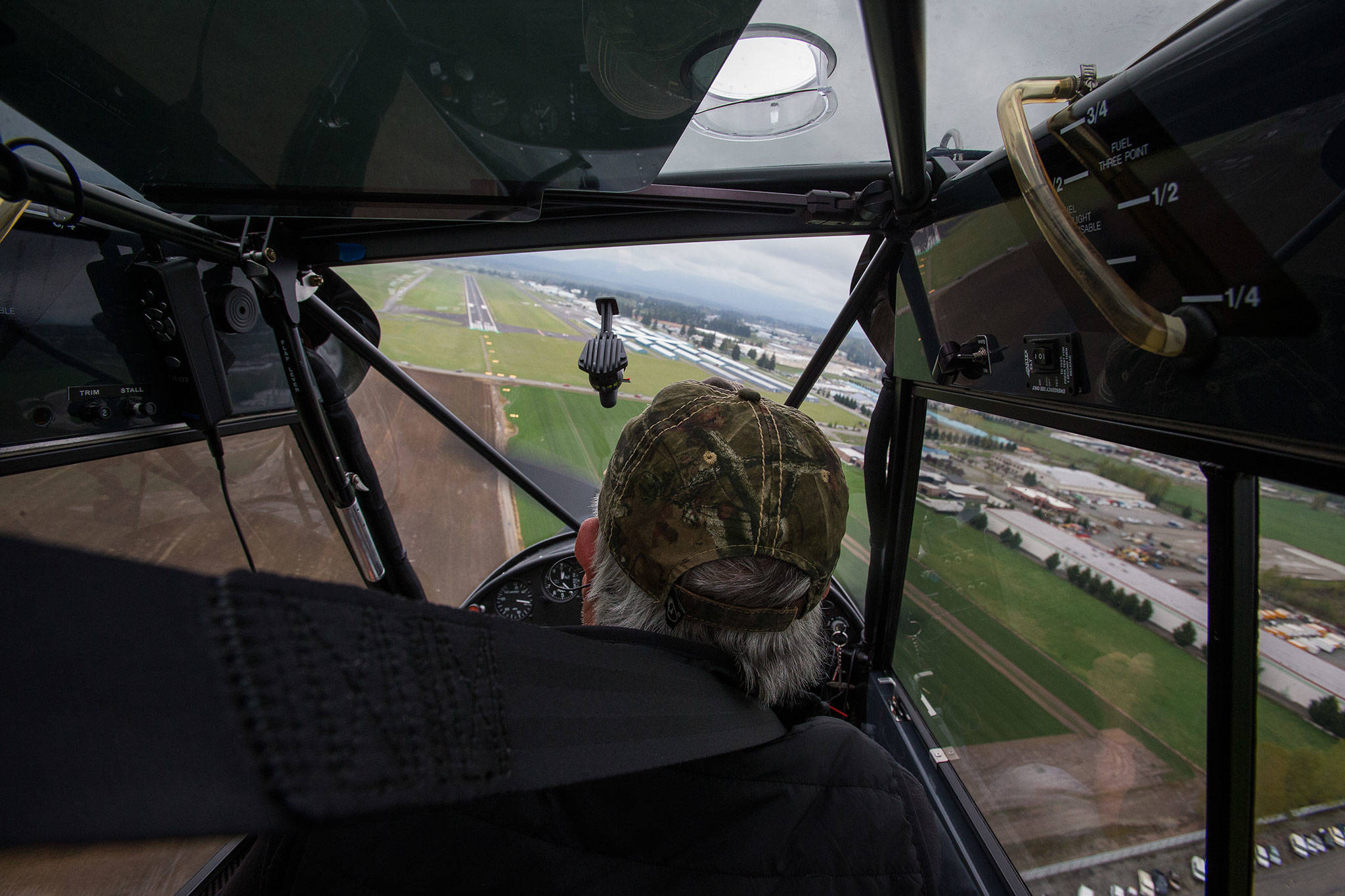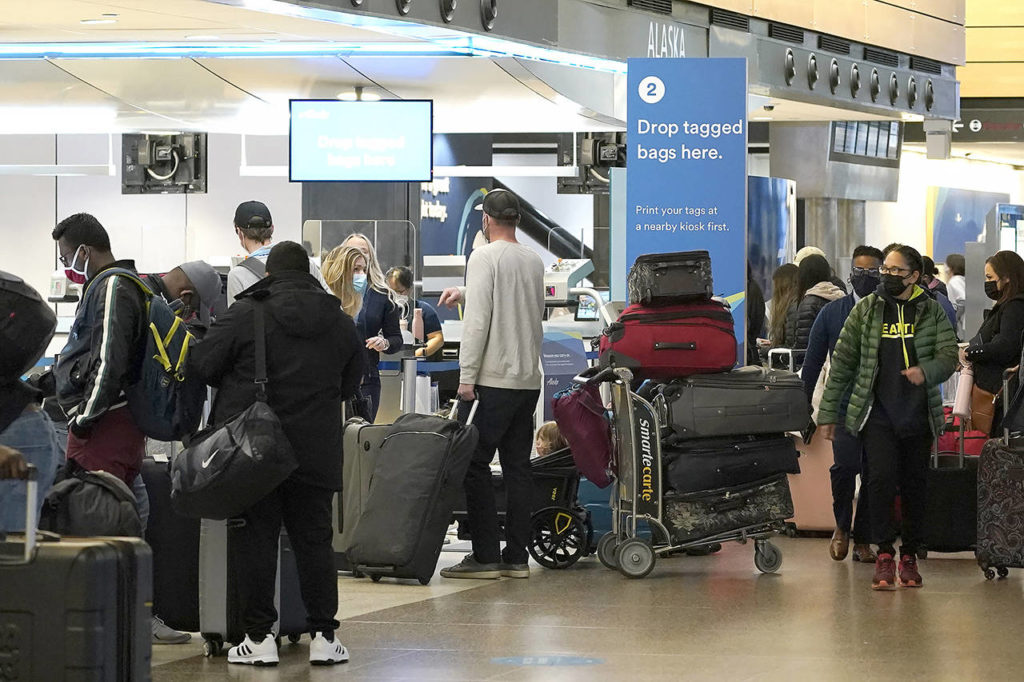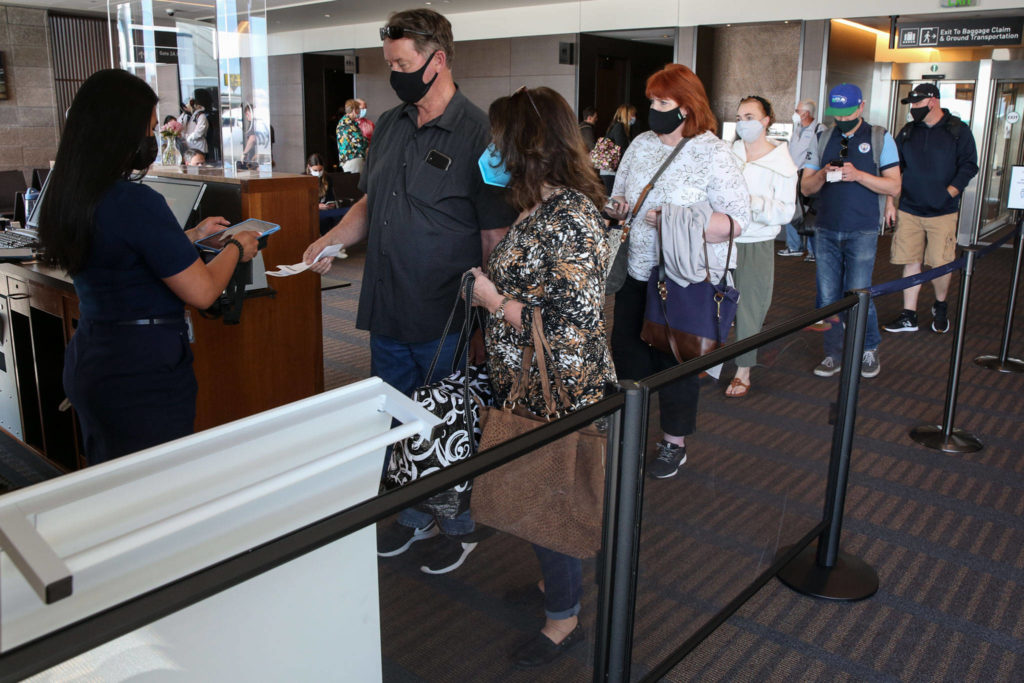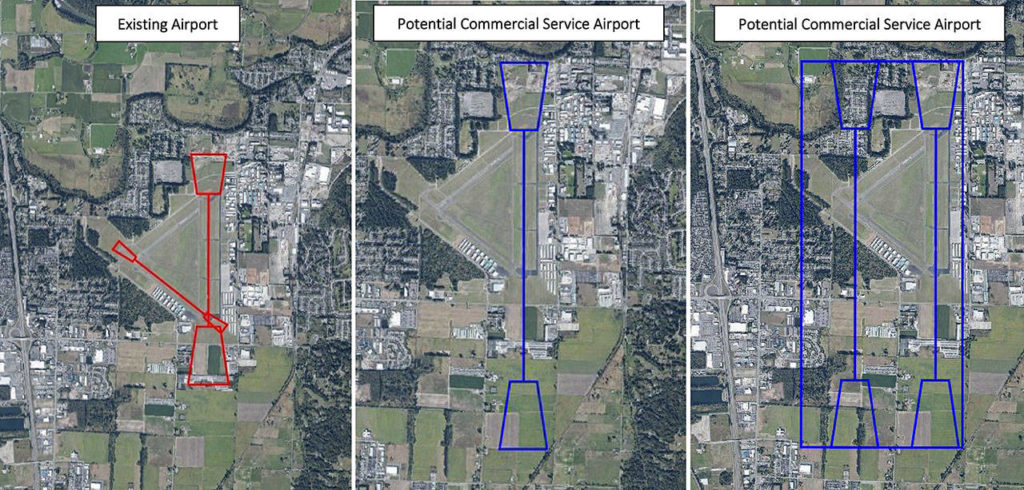EVERETT — Snohomish County’s two biggest airports are considered possible relief valves for explosive aviation growth in coming decades, with a new study of regional capacity daring to explore runway expansion at Paine Field in Everett and at Arlington Municipal.
The recently completed Regional Aviation Baseline Study by the Puget Sound Regional Council does not actually propose expansion at those airports, but it does examine, in broad strokes, the feasibility of adding runway capacity there and at two other airports — Tacoma Narrows and Bremerton National. The two-year, $1.6 million federally funded survey of the region’s 29 airports was completed this spring.
The study is a nascent effort to find additional capacity as Seattle-Tacoma International Airport approaches the limits of its three runways and terminal. The coronavirus pandemic has smothered air travel, but officials think the downturn will be brief and travel growth will resume in earnest.
The report includes aerial images that show where additional runways might be built — in some cases demonstrating the impossibility of such expansion.
In the case of Paine Field, building a big new parallel runway would necessitate the seizure of extensively developed commercial and residential land. Boosting passenger service, however, is feasible, the study says.
Based on a 2018 environmental assessment conducted before the start of commercial service, Paine Field is limited to 24 daily departures, but with additional planning and an environmental review, “it could accommodate more,” the report concludes.
Any expansion at Paine Field would involve Propeller Airports, the privately held company that built and operates the passenger terminal. And such a proposal would likely stir up renewed opposition from nearby communities that fought the present passenger service for years and ultimately lost in court.
On the cargo side, Sea-Tac and King County International Airport (Boeing Field) handle about 85% of the region’s air freight. Paine Field is also a significant cargo depot, but nearly all the shipments are related to airplane production at the Boeing Co.’s Everett assembly plant, the report said.
But Paine Field’s cargo profile could change. Boeing is reportedly in talks with FedEx to sublet the big Dreamlifter facility at Paine Field, which Boeing leases from the Snohomish County-owned airport. FedEx would need the county’s approval for the transfer, and any air cargo operations at the Everett airport would require approval from federal regulators and a possible environmental review.
Overall, regional demand for air cargo capacity is expected to more than double by 2050, growing from a half-million metric tons to over 1.3 million metric tons in 2050.
Arlington: Room to grow?
Arlington Municipal Airport seems to have room for runway growth since its location is not as urban as Paine Field’s.
Today, Arlington Municipal largely serves the general aviation community — everything but scheduled commercial and cargo flights. It has two runways that are 3,498 feet and 5,332 feet long. Based on a visual assessment, the report concludes that “there is potential space for expansion to single or parallel 9,000-foot runways … which would allow for transcontinental and Hawaii air service.”
While the surrounding area would be impacted by the addition of parallel runways, “it does not appear to be significant.” The airport’s development could help meet a portion of the region’s skyrocketing demand for air cargo and passenger service, the report says.
It’s not the first time the Arlington airport has been eyed by the Puget Sound Regional Council for expansion.
In the early 1990s, the planning group offered up the airport and the Marysville area, along with a Pierce County location, as possible sites for a second, major airport. The proposal was abandoned in 1996 when the Port of Seattle decided to build a third runway at Sea-Tac. Despite intense opposition, that runway at SEA was completed in 2008 at a cost of $1.1 billion.
On the ground in Arlington, a proposal to extend to the north the longest runway — by 677 feet, for a total length of 6,009 feet — has been part of the Airport Master Plan for at least 12 years and will be included in a 2024 update, Arlington Mayor Barb Tolbert said.
The added footage would allow the city-owned airport to accommodate corporate aircraft with wider wingspans and faster approach speeds, Tolbert said. Because the present runway is less than 6,000 feet, corporate airplane operators typically pay a 30% higher insurance premium to land there, Tolbert said.
With proximity to a new Amazon fulfillment center, I-5 and rail lines, the Arlington airport has been the object of intense speculation. Many are wondering if Amazon Air or another cargo carrier is scoping out the airfield for future operations. At a recent Snohomish County Airport Commission meeting, some board members — eager to weigh in — wanted to know if air cargo operations were coming to the Arlington airport. Paine Field airport director Arif Ghouse had to remind the advisory board that it only oversees Paine Field, the Snohomish County-owned airport.
So far, no one has approached the city with a proposal, Tolbert said. “None of those companies have talked to us about that,” she said.
State commission
The state Commercial Aviation Coordinating Commission, which is responsible for identifying a single location for a new major commercial aviation facility — a Sea-Tac-caliber site — also views Paine Field as ripe for expansion but differs from the regional council with regard to Arlington.
In a summary of the commission’s findings, Arlington Municipal is described as having “substantial infrastructure development on both ends of the runway (that) restricts expansion opportunities.”
Besides Arlington, the regional council identifies Bremerton National Airport and Tacoma Narrows Airport as potentially able to accommodate single or parallel 9,000-foot runways.
If those three airports were to expand to include commercial service, it could help meet the region’s demand through 2050, the Commercial Aviation Coordinating Commission said.
Demand for commercial passenger service is anticipated to grow from 24 million boardings in 2019 to 52 million by 2050. At the current pace — the COVID-19 pandemic put a crimp in the timeline but travel continues to rebound — demand for air cargo and passenger service is expected to outstrip the region’s airport capacity by 2027, the report said.
Plain and simple, regional population growth and concurrent job growth are the drivers. Metropolitan Puget Sound’s population, now 4.1 million, is expected to reach nearly 6 million by 2050 — on average, an additional 55,000 people each year.
“At the end of the day, there are significant limits to the region’s air capacity,”said Josh Brown, executive director of the Puget Sound Regional Council. “What our analysis tells us is that Seattle-Tacoma International Airport alone cannot support the growing air travel and air cargo needs of the Puget Sound region. That’s the final conclusion.”
Building one additional major commercial airport to accommodate the full demand would require an undeveloped “greenfield” site, but that was not part of the study, Brown said. “We didn’t analyze any greenfield sites — that was not part of our scope,” Brown said.
Looking to Miami and Atlanta
As a future guide, Brown named two metropolitan areas — Miami and Atlanta — that have taken “two, very different approaches” to meet their airport needs.
“If you look out to 2050, the Puget Sound region will have the population that Miami or Atlanta has today — six million people,” Brown said. With only one hub, “Atlanta has the busiest airport in the world,” Brown said. On the other hand, Miami, with three airports, “may be more of a comparison to what our region looks like in the future.”
The Miami area, like Puget Sound, he said, “has three distinct counties and they also deal with some geographic boundaries. They have three complementary airports — Miami International, Fort Lauderdale-Hollywood International Airport in Broward County and Palm Beach in Palm Beach County.”
The Bay Area’s seven million residents also rely on multiple airports — San Francisco, San Jose and Oakland international airports, Brown added.
In virtual public meetings last year that previewed the aviation study, “In general, most people said they preferred spreading capacity and aviation impacts throughout the region rather than concentrating it at one airport,” the Puget Sound Regional Council reported.
The next step in addressing the region’s airport shortage is up to lawmakers and local communities.
Earlier this year, the state Commercial Aviation Coordinating Commission released a preliminary list of six airports for future expansion — Paine Field, Arlington, Bremerton, Sanderson Field in Shelton, Tacoma Narrows and Ed Carlson Memorial Field in Lewis County.
The commission was originally tasked with identifying a single location for a new major commercial aviation facility by 2022 and developing a timeline to ensure it’s up an running by 2040. It now proposes that the deadline for the final recommendation be extended to 2024.
One solution put forth by the commission is to improve existing airports in the near term, while pursuing plans for a large new airport in the next decade or two.
For that purpose, Brown said, the aviation baseline study is expected to be a useful planning tool.
Janice Podsada; jpodsada@heraldnet.com; 425-339-3097; Twitter: JanicePods
Talk to us
> Give us your news tips.
> Send us a letter to the editor.
> More Herald contact information.




























